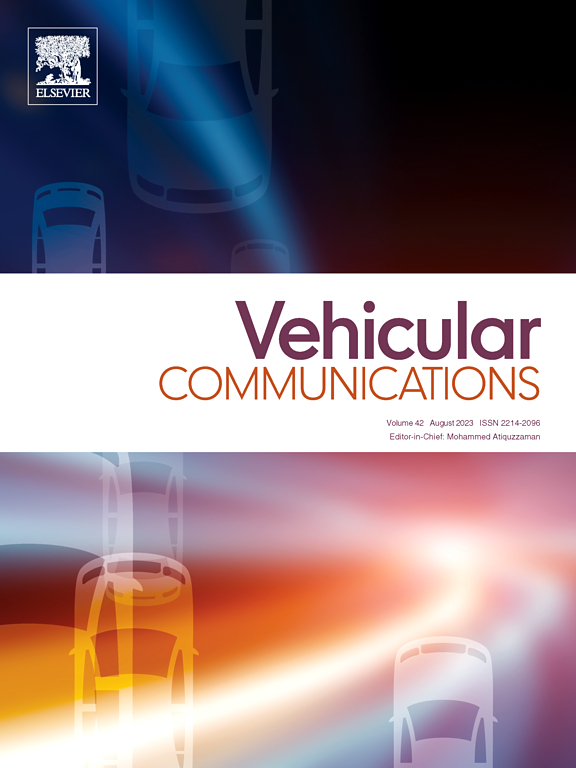基于多智能体深度强化学习的车载通信网络资源分配策略
IF 6.5
2区 计算机科学
Q1 TELECOMMUNICATIONS
引用次数: 0
摘要
在复杂和高移动性的车载通信网络中,快速变化的信道条件、信号干扰和严格的安全服务延迟要求对现有的无线资源分配方案提出了重大挑战。提出了一种新的资源分配方法——AMADRL。它基于多智能体深度强化学习(MADRL)算法,并结合了注意机制(AM)。该方法首先改进了传统的MADRL框架,利用两个临界网络分别估计相应的全局和局部奖励函数,实现了频谱和功率分配的联合优化。这种优化平衡了agent的个体利益和集体利益,满足了车对车(V2V)链路的低延迟通信需求。该方法有效地降低了对V2I链路的干扰。在此基础上,我们进一步将AM整合到框架中。AM使模型能够选择性地关注关键信息,动态调整资源分配策略。仿真结果表明,与随机方法和传统深度强化学习(DRL)方法相比,该算法具有更好的收敛速度和稳定性。有效地满足了不同链路的通信需求,显著提高了频谱效率。本文章由计算机程序翻译,如有差异,请以英文原文为准。
Resource allocation strategy for vehicular communication networks based on multi-agent deep reinforcement learning
In complex and high-mobility vehicular communication networks, rapidly changing channel conditions, signal interference, and stringent latency requirements of safety services pose significant challenges to existing wireless resource allocation schemes. We propose a novel resource allocation method named AMADRL. It is based on the multi-agent deep reinforcement learning (MADRL) algorithm and incorporates attention mechanisms (AM). This method first improves the traditional MADRL framework by employing two critic networks to estimate the corresponding global and local reward functions, achieving joint optimization of spectrum and power allocation. This optimization balances the individual interests of agents with the collective benefits, meeting the low-latency communication requirements of vehicle-to-vehicle (V2V) links. And this method effectively reduces the interference to the vehicle-to-infrastructure (V2I) links. Building on this foundation, we further integrate AM into the framework. The AM enables the model to selectively focus on critical information, dynamically adjusting resource allocation strategies. Simulation results demonstrate that, compared with random methods and conventional deep reinforcement learning (DRL) methods, the proposed algorithm exhibits superior convergence speed and stability. It effectively meets the communication requirements of different links and significantly improves spectrum efficiency.
求助全文
通过发布文献求助,成功后即可免费获取论文全文。
去求助
来源期刊

Vehicular Communications
Engineering-Electrical and Electronic Engineering
CiteScore
12.70
自引率
10.40%
发文量
88
审稿时长
62 days
期刊介绍:
Vehicular communications is a growing area of communications between vehicles and including roadside communication infrastructure. Advances in wireless communications are making possible sharing of information through real time communications between vehicles and infrastructure. This has led to applications to increase safety of vehicles and communication between passengers and the Internet. Standardization efforts on vehicular communication are also underway to make vehicular transportation safer, greener and easier.
The aim of the journal is to publish high quality peer–reviewed papers in the area of vehicular communications. The scope encompasses all types of communications involving vehicles, including vehicle–to–vehicle and vehicle–to–infrastructure. The scope includes (but not limited to) the following topics related to vehicular communications:
Vehicle to vehicle and vehicle to infrastructure communications
Channel modelling, modulating and coding
Congestion Control and scalability issues
Protocol design, testing and verification
Routing in vehicular networks
Security issues and countermeasures
Deployment and field testing
Reducing energy consumption and enhancing safety of vehicles
Wireless in–car networks
Data collection and dissemination methods
Mobility and handover issues
Safety and driver assistance applications
UAV
Underwater communications
Autonomous cooperative driving
Social networks
Internet of vehicles
Standardization of protocols.
 求助内容:
求助内容: 应助结果提醒方式:
应助结果提醒方式:


